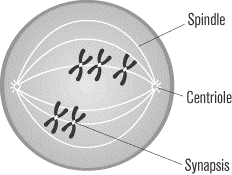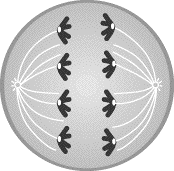But humans and most other complex plants and animals each have a unique set of chromosomes.
This diversity of chromosomes is the result of sexual reproduction, which involves the contribution
of the genetic material from not one, but two parents. During sexual reproduction the father’s haploid
sperm cell and the mother’s haploid ovum (egg) cell fuse to form a single-celled diploid zygote that
then divides billions of times to form a whole individual.
In order for sexual reproduction to take place, however, the parents first need to have haploid sperm or
ova, also called sex cells, germ cells, or gametes. Meiosis is the name for the special type of cell division
that produces gametes.
Process of Meiosis
Unlike the single-cell division of mitosis, meiosis involves two cellular divisions: meiosis I and meiosis II.
Each stage of meiosis runs through the same five stages as discussed in mitosis. During the first round of division,
two intermediate daughter cells are produced. By the end of the second round of meiotic division (meiosis II), the
original diploid (2n) cell has become four haploid (n) daughter cells.
Meiosis I
Meiosis I is quite similar to mitosis. However, there are a number of crucial differences between meiosis I and mitosis,
all of which will be outlined in the discussion of each individual stage below.
Video Lesson - Meiosis II
Interphase I
Just as in mitosis, the cell undergoes DNA replication during this intermediate phase. After replication, the cell
has a total of 46 chromosomes, each made up of two sister chromatids joined by a centromere.
Prophase I
The major distinction between mitosis and meiosis occurs during this phase. In mitotic prophase, the double-stranded
chromosomes line up individually along the spindle. But in meiotic prophase I, chromosomes line up along the spindle in
homologous pairs. Then, in a process called synapsis, the homologous pairs actually join together and intertwine, forming
a tetrad (two chromosomes of two chromatids each, or four total chromatids). Often this intertwining leads the chromatids
of homologous chromosomes to actually exchange corresponding pieces of DNA, a process called crossing-over or genetic
reassortment. Throughout prophase I, sister chromatids behave as a unit and are identical except for the region where
crossover occurred.

Metaphase I
After prophase I, the meiotic cell enters metaphase I. During this phase, the nuclear membrane breaks down,
allowing microtubules access to the chromosomes. Still joined at their crossover regions in tetrads, the homologous
pairs of chromosomes, with one maternal and one paternal chromosome in each pair, align at the center of the cell via
microtubules, as in mitotic metaphase. The pairs align in random order.
Anaphase I
Anaphase I differs slightly from its mitotic counterpart. In mitotic anaphase, sister chromatids split at their
centromeres and are pulled apart toward opposite poles. In contrast, during anaphase I, the centromeres do not split:
the entire maternal chromosome of a homologous pair is pulled to one end, and the paternal chromosome is pulled to the
other end.

Telophase I
During telophase I, the chromosomes arrive at separate poles and decondense. Nuclear membranes re-form around them.
The cell physically divides, as in mitotic cytokinesis.
The Product of Meiosis I
Meiosis I results in two independent cells. One cell contains the maternal homologous pair, with a small segment
of the paternal chromosome from crossover. The other cell contains the paternal homologous pair, likewise with a
small segment of the maternal chromosome. Despite the small region of crossover in the chromosomes of each cell,
the maternal sister chromatids are still quite similar, as are the paternal sisterchromatids . Both cells
formed by meiosis I contain a haploid amount of DNA.
The cells produced in meiosis I are different from those produced in mitosis because both haploid members of
the meiotic pair derive from random assortments of either the maternal or paternal chromosomes from each homologous
pair (with the exception of the small crossover sections). In mitosis, the cellular division separates sister chromatids
and results in diploid cells containing one maternal and one paternal copy in each diploid pair.
Meiosis II
The cells produced by meiosis I quickly enter meiosis II. These cells do not undergo DNA replication before
entering meiosis II. The two cells that move from meiosis I into meiosis II are haploid—each have 23 replicated
chromosomes, rather than the 46 that exist in cells entering both mitosis and meiosis I.
Meiotic division II occurs through the familiar phases from meiosis I and mitosis. To distinguish the phases,
they are called prophase II, metaphase II, anaphase II, and telophase II. One important difference between the
events of meiosis I and II is that no further genetic reassortment takes place during prophase II. As a result,
prophase II is much shorter than prophase I. In fact, all of the phases of meiosis II proceed rapidly.
Video Lesson - Significance of Meiosis
Next to display next topic in the chapter.
Practice Questions
Test Prep Lessons With Video Lessons and Explained MCQ
Large number of solved practice MCQ with explanations. Video Lessons and 10 Fully explained Grand/Full Tests.